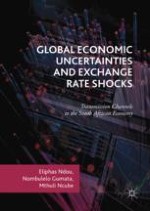2017 | OriginalPaper | Buchkapitel
14. Financial Regulation Policy Uncertainty, Lending Rate Margins and Credit Growth
verfasst von : Eliphas Ndou, Nombulelo Gumata, Mthuli Ncube
Erschienen in: Global Economic Uncertainties and Exchange Rate Shocks
Aktivieren Sie unsere intelligente Suche, um passende Fachinhalte oder Patente zu finden.
Wählen Sie Textabschnitte aus um mit Künstlicher Intelligenz passenden Patente zu finden. powered by
Markieren Sie Textabschnitte, um KI-gestützt weitere passende Inhalte zu finden. powered by
